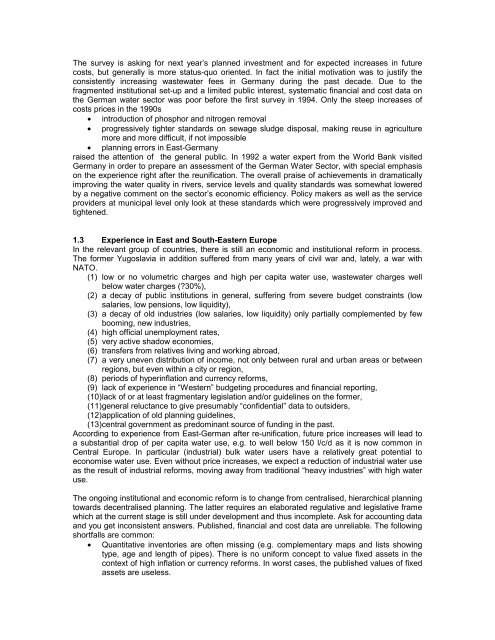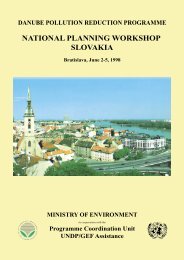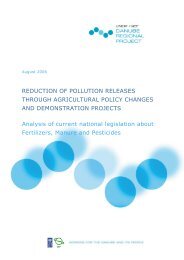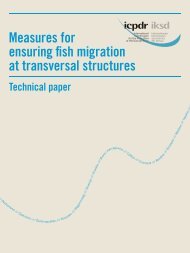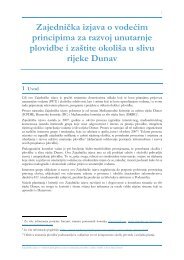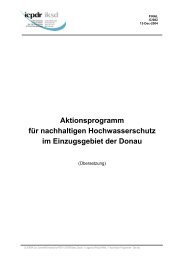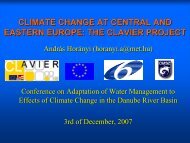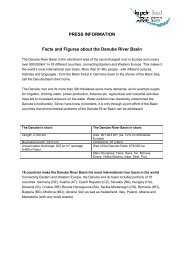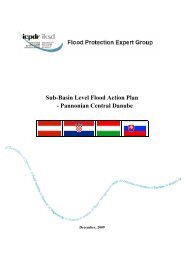Tariff Study Executive Summary - ICPDR
Tariff Study Executive Summary - ICPDR
Tariff Study Executive Summary - ICPDR
You also want an ePaper? Increase the reach of your titles
YUMPU automatically turns print PDFs into web optimized ePapers that Google loves.
The survey is asking for next year’s planned investment and for expected increases in future<br />
costs, but generally is more status-quo oriented. In fact the initial motivation was to justify the<br />
consistently increasing wastewater fees in Germany during the past decade. Due to the<br />
fragmented institutional set-up and a limited public interest, systematic financial and cost data on<br />
the German water sector was poor before the first survey in 1994. Only the steep increases of<br />
costs prices in the 1990s<br />
• introduction of phosphor and nitrogen removal<br />
• progressively tighter standards on sewage sludge disposal, making reuse in agriculture<br />
more and more difficult, if not impossible<br />
• planning errors in East-Germany<br />
raised the attention of the general public. In 1992 a water expert from the World Bank visited<br />
Germany in order to prepare an assessment of the German Water Sector, with special emphasis<br />
on the experience right after the reunification. The overall praise of achievements in dramatically<br />
improving the water quality in rivers, service levels and quality standards was somewhat lowered<br />
by a negative comment on the sector’s economic efficiency. Policy makers as well as the service<br />
providers at municipal level only look at these standards which were progressively improved and<br />
tightened.<br />
1.3 Experience in East and South-Eastern Europe<br />
In the relevant group of countries, there is still an economic and institutional reform in process.<br />
The former Yugoslavia in addition suffered from many years of civil war and, lately, a war with<br />
NATO.<br />
(1) low or no volumetric charges and high per capita water use, wastewater charges well<br />
below water charges (?30%),<br />
(2) a decay of public institutions in general, suffering from severe budget constraints (low<br />
salaries, low pensions, low liquidity),<br />
(3) a decay of old industries (low salaries, low liquidity) only partially complemented by few<br />
booming, new industries,<br />
(4) high official unemployment rates,<br />
(5) very active shadow economies,<br />
(6) transfers from relatives living and working abroad,<br />
(7) a very uneven distribution of income, not only between rural and urban areas or between<br />
regions, but even within a city or region,<br />
(8) periods of hyperinflation and currency reforms,<br />
(9) lack of experience in “Western” budgeting procedures and financial reporting,<br />
(10) lack of or at least fragmentary legislation and/or guidelines on the former,<br />
(11) general reluctance to give presumably “confidential” data to outsiders,<br />
(12) application of old planning guidelines,<br />
(13) central government as predominant source of funding in the past.<br />
According to experience from East-German after re-unification, future price increases will lead to<br />
a substantial drop of per capita water use, e.g. to well below 150 l/c/d as it is now common in<br />
Central Europe. In particular (industrial) bulk water users have a relatively great potential to<br />
economise water use. Even without price increases, we expect a reduction of industrial water use<br />
as the result of industrial reforms, moving away from traditional “heavy industries” with high water<br />
use.<br />
The ongoing institutional and economic reform is to change from centralised, hierarchical planning<br />
towards decentralised planning. The latter requires an elaborated regulative and legislative frame<br />
which at the current stage is still under development and thus incomplete. Ask for accounting data<br />
and you get inconsistent answers. Published, financial and cost data are unreliable. The following<br />
shortfalls are common:<br />
• Quantitative inventories are often missing (e.g. complementary maps and lists showing<br />
type, age and length of pipes). There is no uniform concept to value fixed assets in the<br />
context of high inflation or currency reforms. In worst cases, the published values of fixed<br />
assets are useless.


